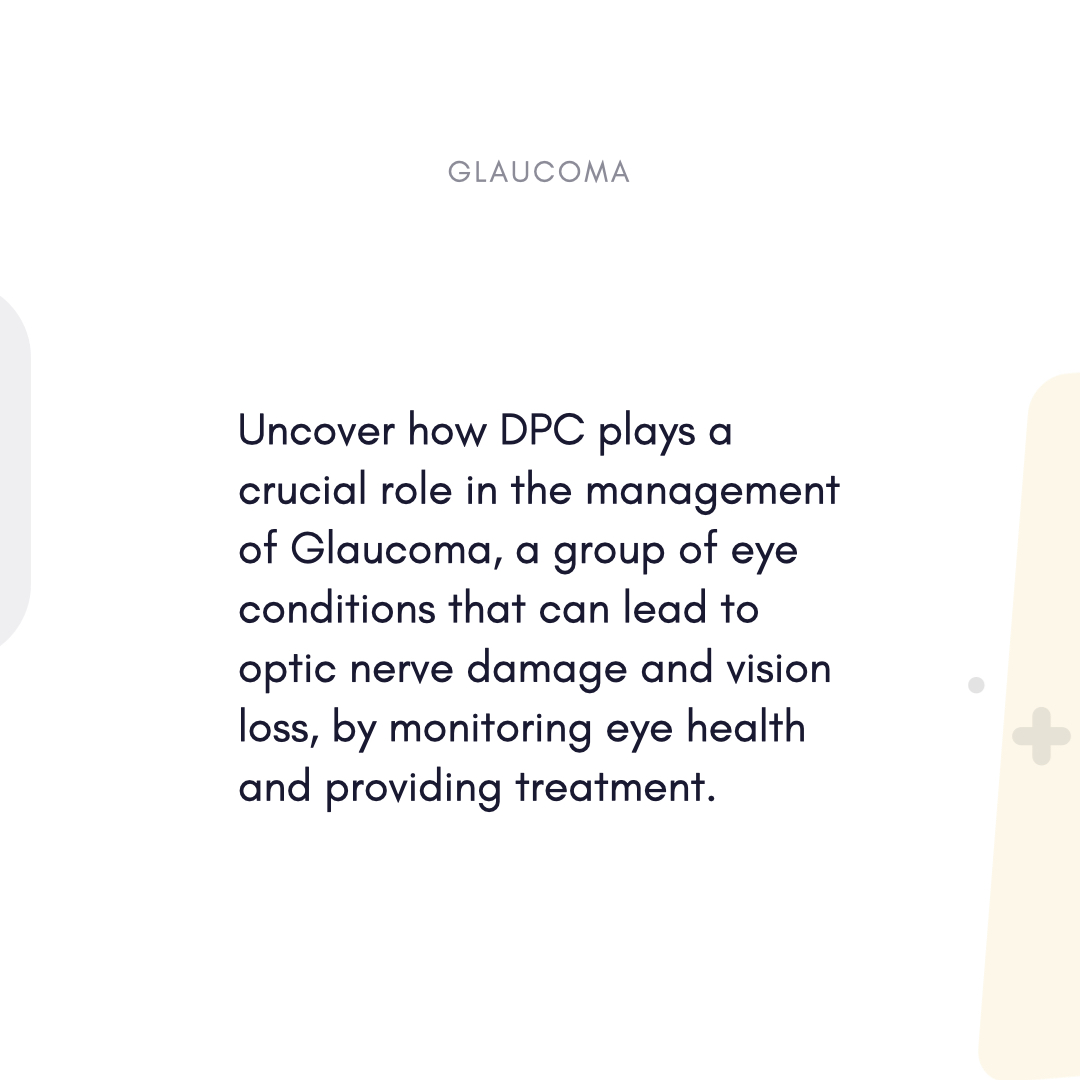Glaucoma and Direct Primary Care (DPC): Protecting Your Vision with Personalized Care
You are not alone if you have been diagnosed with glaucoma; over 3 million Americans suffer with this illness. Glaucoma left uncontrolled can cause permanent vision loss. But you can slow its development and protect your eyesight with proactive monitoring and customized treatment. Without insurance hassles, Direct Primary Care (DPC) provides a simplified, patient-centered method of glaucoma management combining frequent check-ups, expert coordination with eye specialists, and reasonably priced treatment access. DPC helps you to become in charge of your eye condition.

Glaucoma: Understanding
- Usually resulting from increased intraocular pressure (IOP), glaucoma damages the optic nerve and advances silently until vision loss results.
- Important Information:
- Risk factors include family history, diabetes, extreme nearsightedness, and age more than 60.
- Usually none in early stages, late stages could include blind spots or tunnel vision.
- Diagnosis: Optic nerve imaging, visual field tests, tonometry—IOP measurement—diagnosis.
- Long-term risks: Should treatment fail, permanent vision impairment or blindness.
How DPC Changes Glaucoma Care
How DPC Changes Treatment of Glaucoma
Under the membership arrangement known as Direct Primary Care (DPC), patients pay a flat monthly fee—usually between USD 50 and USD 150—for unlimited access to their primary care provider. For those with glaucoma, this means consistent, customized treatment to protect your vision.
DPC transforms glaucoma care by:
- Individualized Treatments Anchored in Medical Expertise:
-
- Focusing on: American Academy of Ophthalmology (AAO) recommendations, DPC providers follow:
- Regular observation: To monitor development, regular IOP checks and optic nerve evaluations.
- Customized treatment plans include eye drop schedules timed to daily activities.
- Specialty Coordination: If necessary, straight referrals to ophthalmologists for laser treatment or surgery.
- Fair, Open Treatment:
- 2. DPC clinics eliminate hidden fees to help to lower costs. Included in your membership are unlimited visits, IOP checks, and care coordination.
- Discounted items: On home tonometers or prescription eye drops, wholesale pricing.
- Early interventions help to prevent expensive complications including vision loss or emergency operations.
- Constant Support for Mental Peace:
- 3. Having 24/7 access to your DPC provider allows you to:
- Change drugs should side effects develop (such dry eyes from prostaglandin drops).
- Talk about unexpected symptoms including changes in vision or eye discomfort.
- Work easily with optometrists and ophthalmologists.
Key Benefits of DPC for Glaucoma Patients
- Same-Day Adjustments: Quick reaction to IOP spikes using direct communication—text, phone, email.
- Holistic Approach: Combining eye health with management of diseases like diabetes or hypertension.
- Long-Term Relationships: Guarantee providers know your background, so enhancing treatment adherence.
DPC Customized Glaucoma Management
The DPC approach fits AAO guidelines for patient-centered eye care:
- Early Intervention:
- To find minute changes, routinely do optical coherence tomography (OCT) scans and visual field tests.
- Lifestyle Advice:
- Diets high in antioxidants (e.g., leafy greens) and activities lowering IOP (e.g., aerobic ones).
- Post-Diagnosis Planning:
- Referrals for minimally invasive procedures and continuous help to modify treatments as glaucoma advances.
Real-Life Success Stories
- Case 1: 68-year-old John battled memory loss around his eye drops. His DPC supplier streamlined his program and added a reminder app. In three months his IOP settled.
- Case 2: Maria, 55, avoided vision loss by DPC's quick referral to an ophthalmologist when her IOP surged suddenly.
Frequently Asked Questions About DPC and Glaucoma
- Q: Can one control glaucoma without having surgery?
- A: Surely. Most people control it with daily eye drops or laser treatment. DPC guarantees close observation to decide whether surgery is required.
- Q: How does DPC respond to crises including sudden vision loss?
- A: 24/7 telehealth support tool links you directly with an ophthalmologist or guides you to urgent care.
- Q: Are home tonometry devices reliable?
- A: Definitely. FDA-approved devices recommended by DPC providers are taught to be used properly to patients.
- Q: Does DPC work with my ophthalmologist?
- A: Perfectly. DPC works on your care plan and shares data to guarantee coherent treatment.
Why DPC Stands Out for Glaucoma Patients
Keystones of the DPC model, early discovery and consistent monitoring are underlined by the AAO. DPC guarantees: by eliminating insurance obstacles:
- Timely Interventions: Change course before damage to vision starts.
- Tools like home IOP monitors let you actively engage in your treatment.
- Trusted doctors monitor your eye condition over decades and adjust their recommendations as necessary.
Take Control of Your Eye Health Right Now
Glaucoma need not rob your vision. With DPC, you find a partner committed to maintaining your sight by reasonably priced, proactive treatment free from delays or bureaucracy.
All set to defend your sight? Look for a DPC provider close by and get medical treatment that gives your eyes top priority.
How DPC Specifically Helps Glaucoma Patients
Rooted in openness, education, and teamwork, DPC's approach directly tackles glaucoma issues:
- Proactive Management: Regular visits find early changes in IOP.
- Direct Communication: Quick access to med-related providers for symptom concerns or questions.
- Affordable Access: To screenings and treatments helps to lower financial stress.






